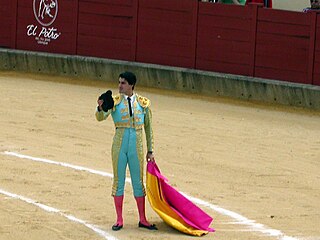
A bullfighter is a performer in the activity of bullfighting. Torero or toureiro, both from Latin taurarius, are the Spanish and Portuguese words for bullfighter and describe all the performers in the activity of bullfighting as practised in Spain, Portugal, Mexico, Peru, France, Colombia, Ecuador, Venezuela and other countries influenced by Portuguese and Spanish culture. The main performer and leader of the entourage in a bullfight, and who finally kills the bull, is addressed as maestro (master), or with the formal title matador de toros. The other bullfighters in the entourage are called subalternos and their suits are embroidered in silver as opposed to the matador's gold. They include the picadores, rejoneadores, and banderilleros.

Rafael Gómez Ortega, also known as El Gallo was an early twentieth century bullfighter. He came from a family of famous bullfighters, including his matador father, Fernando Gómez García and matador younger brother, José Gómez Ortega. He is today remembered for several of his unique fighting techniques such as the espantada - or "sudden flight", which simply consisted of him fleeing when the bull entered the ring. Other techniques included fighting bulls from a chair.

Rafael Guerra Bejarano was born in Cordoba. He was a professional Spanish bullfighter who achieved fame during the 1890s. His uncle, José "Pepete" Damaso Rodriguez Rodriguez, also a professional bullfighter, was killed in Madrid by a bull called Jocinero, on March 6, 1862. In 1878 he started a long apprenticeship as banderillero (banderilla-man) and second swordsman. He became a full bullfighter on September 29, 1887, in Madrid. His sponsor (apoderado) was the bullfighter "Lagartijo" Rafael Molina). On that occasion "Guerrita" said "I trust rather the benevolence of the public than my own merits and will try to fulfil my task by doing my best".

Francisco de Asís Rivera Ordóñez is a Spanish torero or 'bullfighter'.

Ignacio Sánchez Mejías was a Spanish matador.

Spanish-style bullfighting is a type of bullfighting that is practiced in Spain, Mexico, Colombia, Ecuador, Venezuela, Peru, as well as in parts of southern France and Portugal. This style of bullfighting involves a physical contest with humans attempting to publicly subdue, immobilize, or kill a bull. The most common bull used is the Spanish Fighting Bull, a type of cattle native to the Iberian Peninsula. This style of bullfighting is seen to be both a sport and performance art. The red colour of the cape is a matter of tradition – bulls are color blind. They attack moving objects; the brightly-colored cape is used to mask blood stains.

Antonio Cayetano Rivera Ordóñez is a Spanish torero or 'bullfighter'.

Bullfighting is a physical contest that involves a bullfighter attempting to subdue, immobilize, or kill a bull, usually according to a set of rules, guidelines, or cultural expectations.
Jairo Miguel is a bullfighter child prodigy.

The traje de luces is the traditional clothing that Spanish bullfighters wear in the bullring. The term originates from the sequins and reflective threads of gold or silver. These trajes are based on the flamboyant costumes of the 18th-century dandies and showmen involved in bullfighting, which later became exclusive to the bullfighting ritual. Later adornments include the montera hat, more elaborate embroidery, and decorative accessories.

Domingo Ortega was a Spanish matador. Born Domingo López Ortega in Borox, Toledo, he was the son of a farmer, and grew up helping with farm work. During months when there was no work on the farm, he would travel to other towns selling garlic.

Julio Aparicio Díaz, also known as Julito Aparicio, is a Spanish bullfighter from Seville. Aparicio made his public début in bullfighting at the age of fourteen in 1984. He was confirmed as a torero, or matador, in 1994.

Juan José Padilla is a Spanish torero ('bullfighter'). He became a matador de toros, 'killer of (full-grown) bulls', in the town of his birth, Jerez de la Frontera, on June 18, 1994 when he was 21 years old. He was known as the 'Cyclone of Jerez' and featured heavily, both personally and professionally, in Into The Arena: The World Of The Spanish Bullfight, a shortlisted nominee for the William Hill Sports Book of the Year in 2011.

Rodolfo Gaona y Jiménez, was a Mexican bullfighter who performed from 1905 until his retirement in 1925, primarily in Madrid. Known as El Indio Grande and La Califa de León, Gaona was part of the Golden Age of bullfighting in Spain alongside Juan Belmonte and Joselito. He invented the gaonera and pase del centenario moves.

Hilda Eliana Tenorio Patiño is a Mexican bullfighter and matador. She was the first woman to receive her alternativa in the Plaza de Toros México, the largest bullring in the world, aged 24. Tenorio completed her alternativa on February 28, 2010. She has been an outspoken advocate of feminism in the sport. She is the third Mexican woman to attain the rank of matador.
Juan José García Corral, was a Spanish bullfighter and director of the Escuela Tauromaquia of Salamanca
Pablo Lozano Martín, commonly known as La Muleta de Castilla, was a Spanish bullfighter and fighting bull cattle rancher, owner of cattle raising Alcurrucén and "Hermanos Lozano".

Jesús Janeiro Bazán, better known as Jesulín de Ubrique, is a Spanish torero or bullfighter.

José Dámaso Rodríguez y Rodríguez, known as Pepete, was a Spanish bullfighter in the mid-19th century. He was the first notable matador known by this nickname.















